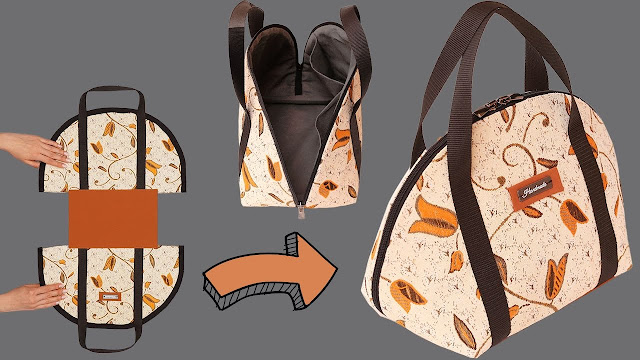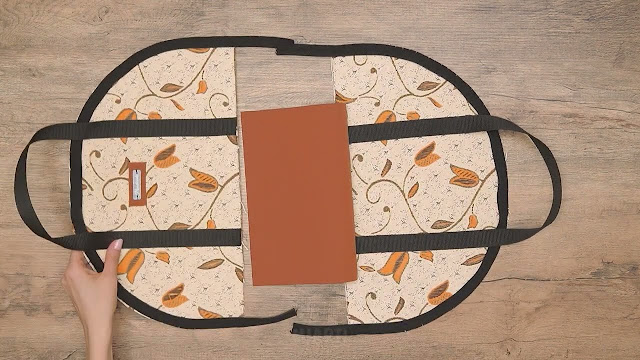Looking for a sewing project that stands out from the crowd? This semi-circular duffle bag is a fantastic choice! With its elegant curved shape, integrated handles, and a secure top zipper, it's perfect for carrying your essentials with a touch of unique style. Whether you need a chic everyday bag, a project bag, or a lovely gift, this design is both practical and eye-catching. The autumn leaf pattern in the image truly highlights how fabric choice can make this bag pop!
This tutorial will guide you through creating this charming bag, focusing on its distinctive rounded panels and central zippered strip.
Why You'll Love This Project:
Unique Silhouette: Its rounded, almost bowling-bag shape is distinctive and stylish.
Integrated Handles: The handles are part of the main panels, providing a clean look.
Secure & Spacious: A top zipper keeps your belongings safe, and the bag offers good capacity.
Customizable: Choose any beautiful fabric to match your personal style.
Intermediate Challenge: A rewarding project to practice curved seams, zipper installation, and working with multiple panels.
What You'll Need:
Main Fabric: Approximately 1 yard (1 meter) of medium-weight woven fabric. Cotton canvas, duck cloth, or sturdy quilting cotton are excellent choices for structure and durability. (The patterned fabric in the image is a great example!).
Lining Fabric: Approximately 1 yard (1 meter) of lightweight cotton or similar fabric.
Webbing/Contrast Fabric for Handles & Trim: About 2-3 yards (2-3 meters) of 1-inch (2.5 cm) wide webbing (like the brown in the image) OR enough contrasting fabric to create trim strips.
Zipper: A plastic or metal zipper, ideally 18-24 inches (45-60 cm) long, matching the length of your bag's central strip.
Medium-weight Fusible Interfacing (Recommended): For added structure to both main fabric and lining pieces.
Sewing Machine: With a universal needle and a zipper foot.
Matching Polyester Thread.
Fabric Scissors or Rotary Cutter and Mat.
Measuring Tape or Ruler.
Fabric Chalk or Washable Marker.
Pins or Wonder Clips: Clips are fantastic for holding curved seams and thicker layers.
Iron and Ironing Board.
Optional: Small "Handmade" tag/label, D-rings for an optional shoulder strap.
Step-by-Step Pattern & Sewing Guide:
Step 1: Create Your Pattern Pieces
This bag is primarily made from two main types of pieces:
Main Curved Body/Handle Pieces (Cut 2 from Main Fabric, 2 from Lining): These are the two large, semi-circular/oval panels that form the main shape of the bag, with the handle sections integrated at the top.
Drawing the Pattern: The image shows these as large semi-circles, with the top inner curve forming the handle opening and the outer curve forming the bag's perimeter.
Decide on the desired width and height of your bag. For example, a bag might be 14 inches (35 cm) wide at the base and 10 inches (25 cm) tall.
Draw a large semi-circle or oval that represents this.
For the handle, draw an inner, smaller semi-circular curve towards the top center. The space between the inner and outer curves at the top will be your integrated handle.
Add 1/2 inch (1.25 cm) seam allowance all around the outer perimeter and the inner handle curve.
Tip: The length of the outer curve of this piece should roughly match the length of your central strip (zipper piece) to be sewn in Step 2.
Central Strip Piece (Cut 1 from Main Fabric, 1 from Lining): This is a long rectangular strip that will form the bottom and top (where the zipper is) of your bag.
Length: This will be the perimeter measurement of your main curved pieces (from one handle attachment point, down the curve to the bottom, and up to the other handle attachment point). A common length for this type of bag might be 30-40 inches (75-100 cm).
Width: This will be the desired depth/width of your bag (e.g., 5-6 inches / 12.5-15 cm).
Add 1/2 inch (1.25 cm) seam allowance all around.
Step 2: Cut Fabric & Apply Interfacing
Cut Pieces: Cut all your pattern pieces from both your main fabric and your lining fabric.
Apply Interfacing (Recommended): Fuse medium-weight fusible interfacing to the wrong side of all your main fabric pieces and corresponding lining pieces for added structure and durability.
Step 3: Prepare Main Body Panels & Handles
Attach Webbing/Trim to Handle: Take one Main Curved Body Piece (main fabric). If using webbing, align the webbing along the top inner curve that forms the handle, wrapping it around the raw edge and stitching it in place. If using contrast fabric trim, create bias binding or a folded strip to neatly finish this inner handle curve.
Alternatively, as shown in the image: The handles appear to be strips of webbing attached to the top flat edge of the main panel, then looped up. To achieve this, cut two pieces of webbing for each handle. Securely attach the ends of the webbing to the flat top edge of each main panel, spaced for comfortable carrying, stitching them within the seam allowance.
Add Optional Tag: If adding a "Handmade" tag or label, stitch it securely onto one of the Main Curved Body Pieces now.
Step 4: Prepare the Central Strip & Zipper
Attach Zipper: Take your Central Strip Piece. Along one of the long edges, place your zipper face down (right side of fabric). Align the zipper tape edge with the fabric edge. Pin securely.
Stitch: Using your sewing machine's zipper foot, stitch the zipper in place close to the raw edge.
Repeat: Repeat for the other side of the zipper, attaching it to the opposing long edge of the Central Strip Piece. The zipper should now connect the two long edges of your strip.
Topstitch: Topstitch on either side of the zipper, parallel to the zipper teeth, for a clean and professional finish.
Step 5: Assemble the Outer Bag
Attach Main Panels to Central Strip:
Open your zipper partway.
Take one Main Curved Body Piece. Divide its outer curved perimeter into quarters and mark. Do the same for the long, open edge of your Central Strip piece (from one end of the zipper to the other).
Align these quarter marks, placing the Main Curved Body Piece (right sides together) to one long edge of the Central Strip. The end of the Central Strip should align with the handle attachment point or where the curve begins.
Carefully pin the entire circumference, easing the fabrics together around the curves. Use plenty of pins or clips.
Stitch this seam with a 1/2 inch (1.25 cm) seam allowance, going slowly around the curve.
Tip: Clip the seam allowances of the curves after stitching to help them lay flat. You can also finish these raw edges with a zigzag stitch or serger.
Repeat for the other Main Curved Body Piece on the other side of the Central Strip.
Step 6: Assemble the Lining
Repeat Steps 3, 4, and 5 for your lining fabric, except:
Do not attach the webbing handles to the lining panels.
Do not attach a zipper to the lining's central strip.
When sewing the main panels to the central strip of the lining (Step 5), leave a 4-5 inch (10-12.5 cm) opening in the middle of one of these long seams. This will be used for turning the bag right side out later.
Step 7: Combine Outer Bag and Lining
Insert Lining: Turn your outer bag right side out. Keep your lining bag inside out.
Nest Bags: Carefully insert the outer bag into the lining bag, so their right sides are facing each other.
Align & Pin: Align the entire top raw edge of the outer bag's zipper opening with the top raw edge of the lining bag's opening. Pin all around the perimeter, matching the side seams.
Stitch: Stitch around this entire top opening with a 1/2 inch (1.25 cm) seam allowance.
Turn Right Side Out: Reach into the opening you left in the lining's side seam (Step 6.1) and pull the entire bag right side out through this hole.
Close Lining Opening: Hand stitch or machine stitch the opening in the lining's side seam closed.
Push Lining In: Gently push the lining into the outer bag. Press the top edge of the bag, ensuring the lining sits neatly inside.
Your Stylish New Semi-Circular Duffle Bag!
You've done it! You've sewn a beautiful, unique, and functional bag. This project is perfect for showcasing a beautiful fabric and makes a wonderful handmade accessory or gift.
Share your amazing bag creations with us in the comments or on social media! Happy sewing!






No comments:
Post a Comment